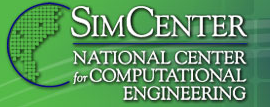 While we were in Chattanooga Tennessee for the GigTank Demo Day on Thursday, our hosts, the Chattanooga Chamber of Commerce took us on a great tour of the city with special attention to services, companies, and educational centers that utilized Chattanooga’s 1gb fiber optic network. Chattanooga was the first city to have 1gb ethernet fiber, a year before Kansas City and Google.
While we were in Chattanooga Tennessee for the GigTank Demo Day on Thursday, our hosts, the Chattanooga Chamber of Commerce took us on a great tour of the city with special attention to services, companies, and educational centers that utilized Chattanooga’s 1gb fiber optic network. Chattanooga was the first city to have 1gb ethernet fiber, a year before Kansas City and Google.
One of the stops on the tour was the University Of Tennessee’s Sim Center: National Center For Computational Engineering.
The SimCenter was established at Mississippi State. With the help of the Jack Lupton Foundation a SimCenter was established in Chattanooga in 2002. The SimCenter houses 6 super computers with the largest having 1300 cores and 325 node diskless cluster by Dell. There are 4gb of RAM per node and of course it’s hooked up to the 1gb ethernet.
Since it’s inception the SimCenter has worked for clients in the public, private and government sectors which require unheard of large amounts of data. When a company like Boeing needs to simulate new turbine engines for a new airplane project the SimCenter is able to simulate the airplane in various conditions to accurately calculate the data engineers need to know while designing new engines.
A recently completed SimCenter project for US Express truck lines resulted in $68 million dollars in fuel savings. The SimCenter did simulated data trials and research on drag and turbulence. They found that by adding “skirts” in three places on semi trucks and their trailers, US Express could save on millions of dollars on gas.
You want me to get to the Zombies part right?
A research project for the SimCenter that was commissioned by the Department of Defense after 9/11 was recently declassified. The Department of Defense used the SimCenter to simulate catastrophic events. More importantly though, the SimCenter research was vital in finding ways to quickly contain a public catastrophe, limiting casualties and losses and protecting first responders as best they could.
Through their super computers, and units called GENI’s, as well as sensors, and communications equipment all linked together on a super fast network, the SimCenter was able to simulate a hazardous materials spill and explosion. In a situation that would typically take hours to contain and more hours to clean up, using the SimCenters’ simulation they were able to:
– Give first responders on going data pertaining to atmospheric conditions, environmental threats, and the trajectory of where the “cloud” of hazardous materials would go.
– They were able to get first responders to the scene quicker by pinpointing the accident
– They were able to alert the citizens through a smartphone app, essentially evacuating the at risk area before any major harm could be done.
Through this study municipalities and local governments will be able to construct a similar system of super computers, sensors, communications and network to be able to respond to their own disasters just as quickly. As gigabit ethernet emerges we will see more and more public safety resources relying on that super fast internet to get vital life saving information to and from command centers, to first responders, to the public and to the media.
The SimCenter opened in Chattanooga long before 1gb ethernet was available. The computer power alone coupled with the brain power of the engineering researchers in the SimCenter have provided research covering everything from lithium battery modeling, aerodynamic analysis, heavy truck modeling (see above), modeling of coastal and urban flooding and much more.
Our host for the presentation about SimCenter, SimCenter Enterprises President and CEO Tim Walsh, did tell us that the gigabit fiber provides even newer ways to utilize the center. Walsh was a mentor for some of the GigTank teams who were looking to send huge amounts of data over the internet.
Gigabit ethernet tackles huge problems for big data projects like the ones at the SimCenter. During the GigTank presentation for Banyan, the entrepreneur team that won, revealed that it would be quicker for an engineer at Stanford to drive to the airport and fly to London with a terabyte hard drive than it would be to send it over a 100/mbps connection. Using Chattanooga’s gig the Banyan team was able to send a Terrabyte of data to Standord in 2.5 hours. That coupled with the computing power of the SimCenter will mean even bigger things will be done at this amazing institution.
Linkage:
Visit the SimCenter website here
More Chattanoga coverage on nibletz.com here
We’re the voice of startups “everywhere else” here are more startups from “everywhere else”

